Understanding Neurodiversity: 4 Tips for Teaching Music Students with Disabilities
This post may contain affiliate links. If you purchase something through an affiliate link, I will receive a small commission at no cost to you. For more information, read the disclosure statement here.
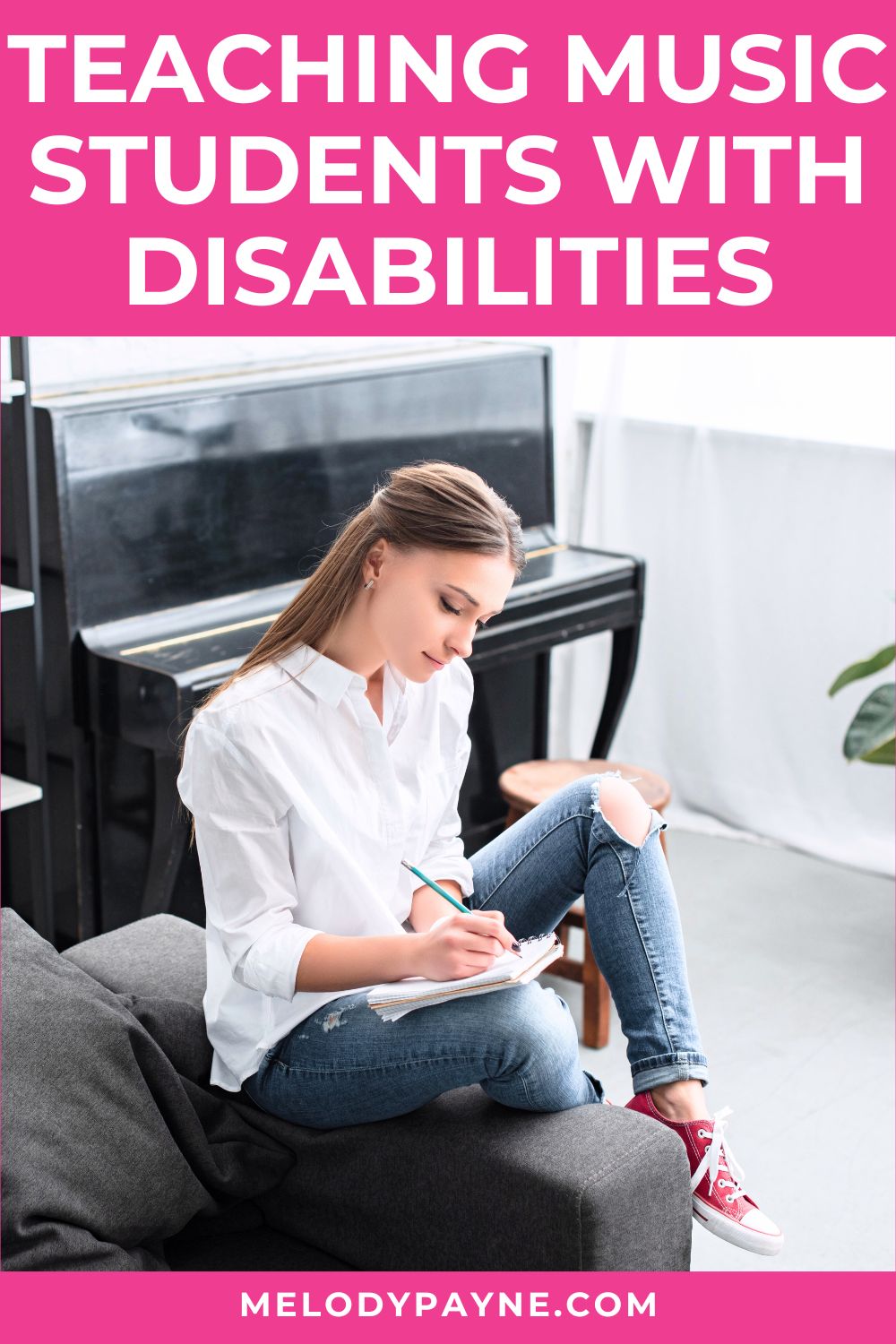
When it comes to teaching music students with disabilities, Dr. Elizabeth Davis-Everhart is a mastermind! We are delighted to have her guest post today.
I was incredibly honored when Melody asked if I would write a guest post on my favorite topic: teaching neurodivergent learners!
Whether you’re new to the piano teaching profession, a seasoned veteran educator, or somewhere in between, you know that each student is unique with their own strengths and perspectives.
Isn’t that the fun of teaching—helping each student discovery and cultivate his or her own gifts and abilities so they can experience joy through music?
One of my favorite aspects of being a music educator is helping students find their musical voice and problem-solving the challenging aspects of teaching students who learn differently, whether it be a 4 year-old savant or a 10 year-old with autism and OCD.
Regardless of whether or not you are currently teaching music students with disabilities, I hope these teaching tips will not only give you some fresh ideas for your students but will also broaden your perspective to the positive aspects of teaching neurodivergent students. (And these tips will apply to your neurotypical students, too!)
Take Notes to help Teaching Music Students with Disabilities
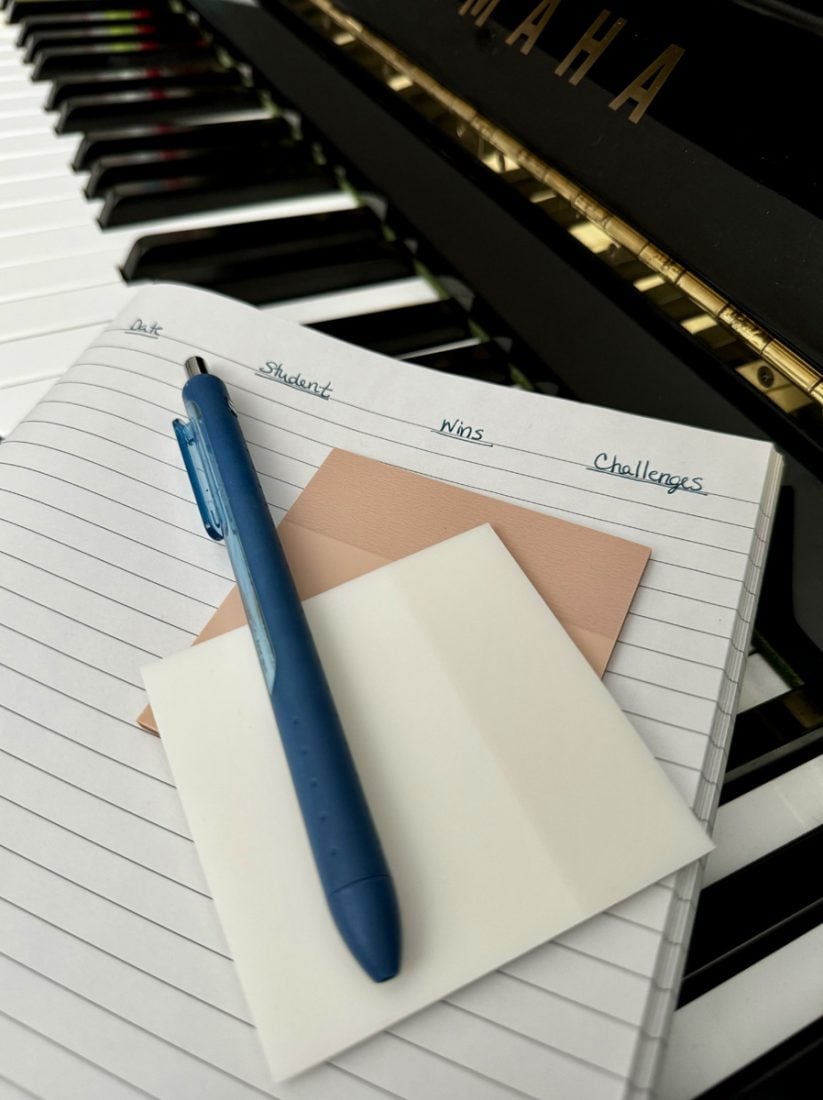
When I was in high school, my grandpa prompted me to write down research interests, books I read, ideas, and wins/challenges in a notebook.
For the last almost 20 years of teaching, I have kept notes of wins and challenges in my teaching for young learners, undergraduate group piano classes, and private lessons, and it has hugely impacted my teaching approach.
Whatever the school year looks like for you (group piano, private lessons for kids/adults, challenging or easy students, etc.) I strongly encourage you to take note of your wins and challenges with your students.
This is particularly helpful in teaching music students with disabilities so you can track behaviors, successes (and what made it work), and failures (and what preceded it), and then use that information to adapt your teaching approach.
This doesn’t have to look like a formal journal or fancy digital document (although it certainly could!), just pull up a Google Sheet/Google Doc or Evernote and type your students’ name, the date of the lesson, and two columns: Wins and Challenges.
My notes are seldom lengthy, eloquent sentences and most often take the form of bullet points. I usually keep a little notebook or sticky notes close to the piano so I can jot down little notes as I teach.
For example, the “Challenges” column in yesterday’s teaching log for one student says: “intervallic reading, direction- what does she know?”
This helps me remember to plan a specific activity for the next lesson to assess this particular skill so I can best know how to help my student.
And yes, those wins and challenges also help me plan my lessons, too—it’s a win-win!
The best method for teaching music students with disabilities
During the first few years of teaching piano and elementary music, one of my first solutions to a problem was to quickly grab my computer and look up all the music blogs and online stores to find a product, game or activity to fix the issue.
Whether it was a struggle of classroom management, keeping a class or students’ focus or teaching students to keep a steady beat, there was an activity for everything, and this is still true—there’s an online resource to ‘fix’ every problem.
“Piano method series are both very right and disastrously wrong.”
This is a quote from one of my pedagogy courses for teachers, and while it sounds like a contradictory statement, it’s very accurate!
Any given piano method or teaching material can be absolutely perfect for one student and result in disaster and frustration for another.
This is true for all of our students, but is especially important to remember when teaching music students who learn differently.
This year in my piano studio, I’m using between 6-8 different methods/series and honestly, some of them aren’t my absolute favorite, but they are working really well for my students.
Why does it matter?
Your teaching approach will always be more impactful and effective than the method and materials you use!
Rather than searching for a method designed for teaching students with autism, dyslexia or ______ (fill in the blank), hone your teaching approach by researching those disabilities, talking with experts and learning the best ways to teach.
Then you won’t be held hostage to a specific method or material because you will be the method!
Always remember that piano methods are simply a tool we use in teaching music students with disabilities, and we as teachers do the actual teaching.
Methodology > method.
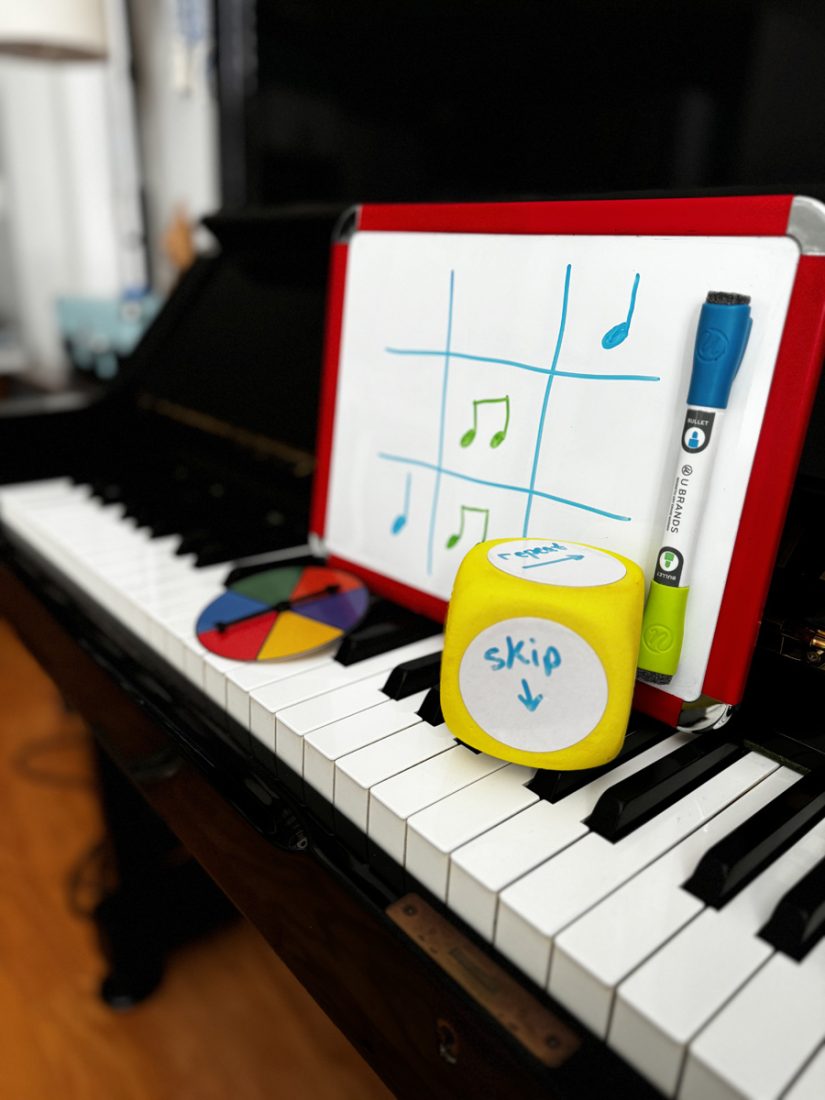
But have you tried the ear when teaching music students with disabilities?
As pianists and piano educators, it’s an engrained philosophy and mentality to focus on the fingers.
The power of piano playing and learning to play the piano is all in the fingers … right?
Please don’t misunderstand—I do focus heavily on building healthy technique in my students from their first lessons, but I think we may sometimes forget that it’s not all in the fingers.
A very common struggle in teaching music students with disabilities is the music reading process.
It can feel like such a tiresome and frustrating journey to not only teach students to recognize and read notes, but to help them become fluent readers can feel like an impossible feat.
Another layer to this conundrum is that nearly all neurodivergent students have highly gifted ears and playing by ear might come more easily to them than reading music. (Did you know that a high percentage of individuals with autism have perfect pitch?)
Music reading is important, but what is one of the most integral aspects of reading music?
Patterns!
Steps, skips, pentascales, chords, major/minor, melodies, harmonies—all patterns, and all patterns that we can introduce and reinforce by ear when teaching music students with disabilities.
Helping your students make sense of all these aural patterns will only add to their confidence in identifying them, playing them fluently, and in recognizing them visually in the music.
Ear training sounds like an intimidating and scary phrase because we often think of this in a clinical way, but ear training can be a barrel of fun!
I’ve yet to meet a student of any ability, age or level who doesn’t have a blast when we play ear training ‘games’ using intervals, or when I play a short 3-4 note melody and they try to play it back.
The possibilities are truly endless, and educating our students’ ears only helps their fingers become more confident in playing all these beautiful patterns!
(for more ideas on concrete sequential ear training, check out 5 Good Reasons To Teach Piano Students How To Improvise)
When in doubt, keep it concrete while teaching music students with disabilities
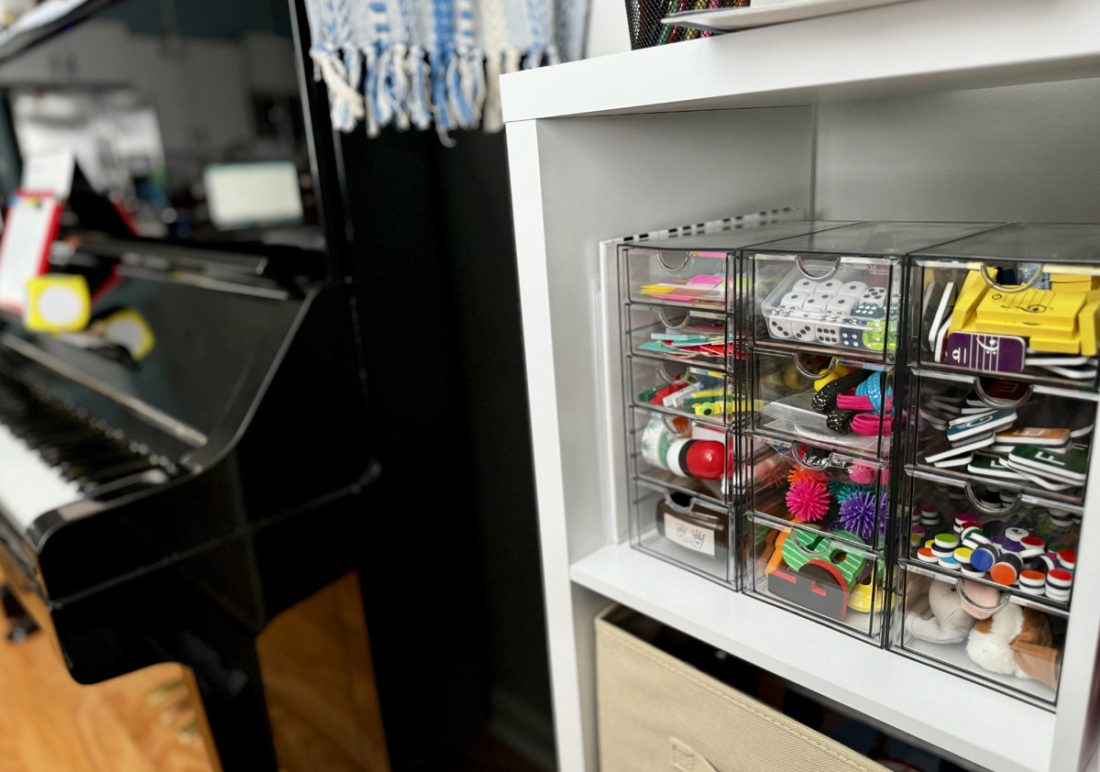
“Is it secret? Is it safe?”
If you’re a fan of the ever-popular Tolkien series “The Lord of the Rings,” then you will quickly recognize that quote as one from Gandalf to Bilbo as he intensely asked about the status of The Ring—was it secret and was it safe? (Yes, I’m a book nerd, too!)
For teaching music students with disabilities—or any students—a great way to problem-solve an issue in a lesson or plan your instruction/pacing/lesson is to ask this simple (but deeply profound) question: “Is it concise? Is it concrete?”
Much of the frustration in teaching music students with disabilities arises when we have an issue with communication: either the giving of it through instructions and struggling to know how to phrase things, or the receiving of it from our students and trying to discern the source of their frustration.
The next time you plan a lesson for your neurodivergent student or a student who is easily overwhelmed, try asking yourself:
Is it concise?
Am I using extraneous verbiage that sounds lovely but isn’t adding to the quality or impact of my teaching?
Keep it short and sweet, when teaching music students with disabilities (or any students, for that matter).
Just tell your student exactly what they need to know.
Is it concrete?
Concrete language is a common term in the special education world, and it simply means to say what you mean, mean what you say.
I first heard this term when studying pedagogy with Dr. Scott Price and it completely changed my teaching approach.
Think in concrete terms rather than abstract and focus your instructions on what the student needs to do to play the piece or that phrase.
What do their fingers need to do? That’s what they need to know!
Teaching music students with disabilities can be a challenging process, but the musical journey doesn’t have to be clouded by those challenges.
Neurodivergent students are bright, capable musicians and if we stay focused on learning from our teaching, maintain good communication, remain dedicated to being the method and nurturing our students’ strengths, music can be a beautiful place for students with disabilities to thrive and find endless joy!
Video Demonstration for Teaching Music Students with Disabilities
I thought it would be fun to show you a few easy ways to incorporate ear-training with your neurodivergent students, so here are a couple of my favorite games and activities.
I hope you find them helpful and that they give you some ideas to adapt for your own students, whether you’re teaching music students with disabilities or not.

Don’t see the video above? Watch it here.
Need even more ideas when teaching music students with disabilities?
These blog posts are full of creative ideas that can help you teach outside the box!
Don't miss out!
Follow on Facebook and Instagram, join the best Facebook group for piano teachers, and subscribe to the newsletter to get helpful teaching tips, resources, and tutorials delivered straight to your inbox every week.
Elizabeth Davis-Everhart
Elizabeth Davis-Everhart
Welcome!
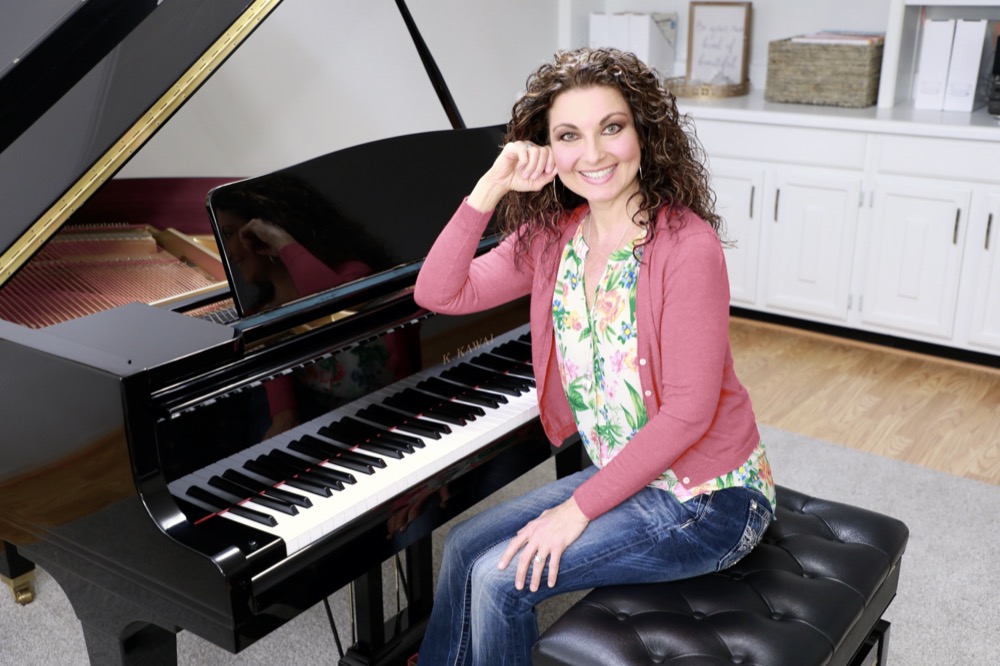
Hi! I’m Melody Payne, a pianist and piano teacher, educational resource author, a fun-loving wife to the most wonderful and talented hubby I could ask for, and a lifelong learner who loves to share. I want to make your life as a music teacher easier by writing and sharing helpful and relevant music teaching articles, and by creating educational resources with your very own students in mind. If you are a parent who wants to enroll your child in piano lessons, I’d love for us to get started building those skills that can give your child a lifetime of musical enjoyment!


This Post Has 4 Comments
Thank you again for the warm invitation to share on your blog, Melody! You do so much to enrich the lives of teachers.
Thank you so much for being wiling to share your expertise about such an incredibly important aspect of teaching, Elizabeth! There is so much to learn, and we’re so grateful for your leadership in this area!
Thank you for this blog and the video. Just what I needed: some simple ear training exercises. I definitely have some students in mind to try this.
I do too, Julie! And I’m grateful that Elizabeth was willing to share her fantastic ideas with us so we can better help our students.